Rates paid on Bank of Jamaica 30 days CDs dropped for a second week at the latest auction on Wednesday this week, to 8.49 percent from 8.85 percent on March 22.
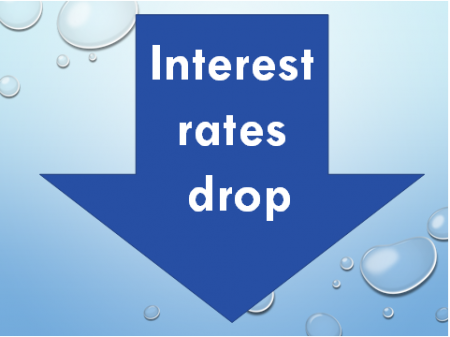 The rate declined from 10.54 percent at the auction on March 17 after BOJ offered $18 billion, which attracted $57.86 billion on March 22. At this week’s auction, $35 billion was offered by the central bank and attracted $70 billion, resulting in the highest successful rate at 8.85 percent and the lowest at 7.5 percent, down from 8.2 percent the week before. BOJ absorbed $88.85 billion at the end of the CD auction, up from $81.85 billion the previous week but still down sharply from a peak at $109.5 on March 1.
The rate declined from 10.54 percent at the auction on March 17 after BOJ offered $18 billion, which attracted $57.86 billion on March 22. At this week’s auction, $35 billion was offered by the central bank and attracted $70 billion, resulting in the highest successful rate at 8.85 percent and the lowest at 7.5 percent, down from 8.2 percent the week before. BOJ absorbed $88.85 billion at the end of the CD auction, up from $81.85 billion the previous week but still down sharply from a peak at $109.5 on March 1.
The move brings the CD rates in line with Treasury bills, with an average rate for 90 days coming in at 8.21 percent on March 8.
BOJ CD rate drop for a second week
Interest rates held at 7% for Jamaica
Interest rates set by the Bank of Jamaica held at 7 percent for the overnight deposits, even as inflation continues to fall rapidly in the country and now running at an average of 0.20 percent per month or 2.4 percent annualised since November last year. The monetary Policy Committee determined the decision at meetings held this week.
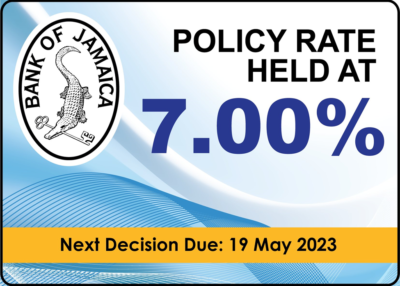 According to the country’s central bank, “Inflation continued to ease, consistent with Bank of Jamaica’s monetary policy and international developments. Jamaica’s inflation rate to February 2023 of 7.8 percent was below the rate of 8.1 percent at January 2023. The February outturn was the lowest rate since December 2021.”
According to the country’s central bank, “Inflation continued to ease, consistent with Bank of Jamaica’s monetary policy and international developments. Jamaica’s inflation rate to February 2023 of 7.8 percent was below the rate of 8.1 percent at January 2023. The February outturn was the lowest rate since December 2021.”
The key external drivers of headline inflation, such as grains, fuel and shipping prices, continued to decline, broadly in line with the Bank’s expectations. In addition, inflation expectations continued to track.
Core inflation (excluding food and fuel prices from the Consumer Price Index) at February 2023 also decelerated to 6.6 percent from 7.1 percent at January 2023 and is projected to fall further as monetary policy remains tight.
Annual inflation is projected to continue to fall to the Bank’s inflation target range of 4 to 6 percent by the December 2023 quarter. One-off regulated price adjustments may, however, result in a temporary uptick in inflation.
Notwithstanding positive developments in inflation, “the MPC noted that the risks to the inflation outlook remain elevated. In a context where the domestic economy continues to grow, labour market shortages carry the potential for future wage adjustments that can put upward pressure on inflation.
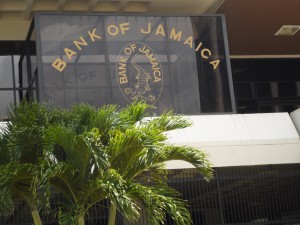
BOJ holds overnight rate.
Higher inflation could also result from a worsening in supply chain conditions and higher commodity prices if there are further geo-political disruptions. Among the factors that could lead to lower-than-projected inflation, weaker-than-expected global growth could negatively affect domestic demand, and some projected adjustments to regulated prices may not materialise.”
“Therefore, to continue underpinning inflation returning to the target range and to underwrite continued stability in the foreign exchange market, the MPC unanimously agreed to hold the policy interest rate at 7 percent, to maintain tight Jamaican dollar liquidity in the money market and to continue fostering relative stability in the foreign exchange market. The Bank’s liquidity management strategy incorporates the impact of the one percentage point increase in the domestic and the foreign currency Cash Reserve Requirements applicable to DTIs, effective the beginning of April 2023.”
Time come for BOJ to start cutting interest rates
Interest rates in Jamaica and around the world were pushed up since 2021 to curb inflation that got out of hand, in the process Bank of Jamaica hiked their overnight rate that was from 0.50 percent up to August 2021 to a high of 7 percent in November last year, since then point to point inflation peaked in April last year at 11.8 percent, but has since declined sharply by 34 percent to February this year, with the pace since November last year running at 44 percent below the similar 2021 period.
 The fall since 2021 has been consistent, although the rate for a few of the months exceeded this pace. The average monthly inflation rate has dropped from the 2022 level of 0.6 percent per month from November 2021 to October 2022 and is now running at an average of 0.2 percent per month or 2.4 percent per annum over the last five months, well below the Bank’s target of 4-6 percent per annum. If history is anything to go by, the next three months should see relatively low inflation, suggesting that the current average of 0.2 per month could continue for a few more months.
The fall since 2021 has been consistent, although the rate for a few of the months exceeded this pace. The average monthly inflation rate has dropped from the 2022 level of 0.6 percent per month from November 2021 to October 2022 and is now running at an average of 0.2 percent per month or 2.4 percent per annum over the last five months, well below the Bank’s target of 4-6 percent per annum. If history is anything to go by, the next three months should see relatively low inflation, suggesting that the current average of 0.2 per month could continue for a few more months.
The Bank of Jamaica’s target is close at hand based on the point to point inflation, with the danger now that the rate could fall well below the lower end of the band if the BOJ does not act soon to lower interest rates.
They seem to have taken a first step by reducing the amount of money they are pulling out of the market, with the total amount of CDS dropping from $109.5 billion at the beginning of March to $82 billion at the last auction in March.
 Investors who were receiving negative interest rates are now seeing positive rates for the first time since 2019 and the trend suggests that this will become more positive over the next few months as inflation continues to fall to more acceptable levels.
Investors who were receiving negative interest rates are now seeing positive rates for the first time since 2019 and the trend suggests that this will become more positive over the next few months as inflation continues to fall to more acceptable levels.
Government wage settlement and the minimum wage hike will pressure inflation, but interest rates at current levels are no longer warranted. Other developments in favour of lower inflation are a fall in the price of Oil on the world market from US$80 in early February when the last CPI was computed, and is now trading around $70 but fell as low as $65 in March, with some expecting more declines in the months ahead. The Jamaican dollar has been appreciating and is now down to J$151 region, thus having a moderating effect on prices across a wide cross section of goods and services.
Remittances up in January for Jamaica
Remittance inflows into Jamaica rose 2 percent to US$248.6 million for January 2023, up from US$243.7 in 2022, data out of Jamaica’s central bank show and represent the 6th monthly increase since January last year, with increases in the first two months of the year, as well as August, November and December.
 The slow increase for January is in stark contrast to some others in the region. Guatemala and Mexico with growth of 17.4 percent and 12.5 percent respectively and El Salvador with an increase of 6.4 percent, the Bank of Jamaica report shows.
The slow increase for January is in stark contrast to some others in the region. Guatemala and Mexico with growth of 17.4 percent and 12.5 percent respectively and El Salvador with an increase of 6.4 percent, the Bank of Jamaica report shows.
Remittances in 2021 amounted to 58 percent of Imports, down from 61 percent in 2020 but only 37 percent in 2019 and 135 percent of the inflows from the tourist industry in 2021, 206 percent in 2020 and 67 percent in 2019. The ratio for tourism would have declined in 2022 and below the 100 percent level for 2023 based on the sharp recovery in that industry in 2022 and so far in 2023.
Tourist arrivals up nearly 50 percent in February
Tourist arrivals in February this year are up nearly 50 percent, according to data showing passenger movements through the Sangster International Airport in Montego Bay, while the Norman Manley airport in Kingston saw a 43 percent increase in passenger movements for the same period compared with 2022.

Growth in tourism is expected to be big in 2023
Aeroportuario del Pacifico, which manages the airports in Montego Bay and Kingston, Jamaica, saw the total number of passengers at Montego Bay Airport increase by a robust 49.5 percent in February 2023, moving from 274,700 total movements in February 2022 to 410,700 in February 2023. For the first two months of the year, Montego Bay Airport saw total passenger movements increase by 58.4 percent, from 542,300 in 2022 to 859,100 in 2023.
Kingston’s Norman Manley International Airport, which processes far fewer passengers than Montego Bay, handled 112,200 passengers in February 2023, 43 percent more than the 78,400 managed in February 2022. In the first two months of 2023, Kingston’s Airport saw passengers grow by 52 percent, from 169,900 in 2022 to 258,200.

Dolphin Cove to be a big beneficiary of turn in tourism in 2023.
The improvement in one of the most important industries within the Jamaican economy will drive growth and have an overall positive effect on some sectors more than others. Accordingly, the agricultural and transportation industries are two areas that will see immediate impact, as tourists have to be transported to and from airports and others areas within the country and have to be fed, with a large portion of the menu comprising goods that are produced or sold locally. From a stock market standpoint, some companies will benefit considerably and others less. Companies such as Everything Fresh, Caribbean Producers, Dolphin Cove, Express Catering, which generate a considerable portion of their business directly with the sector, will significantly improve revenues and profit. Companies such as Jamaica Broilers, Wisynco Group, Grace Kennedy, Knutsford Express and Seprod.
Remittance inflows to Jamaica fall
 Remittances inflows to Jamaica amounted to US$3.440 billion in 2022 a 1.6 percent fall from inflows of US$3.497 billion in 2021, the first year of decline since 2014, data out of Bank of Jamaica show.
Remittances inflows to Jamaica amounted to US$3.440 billion in 2022 a 1.6 percent fall from inflows of US$3.497 billion in 2021, the first year of decline since 2014, data out of Bank of Jamaica show.
2022 is the second year that inflows exceeded the $3 billion mark, although 2021 came close with $2.905, $492 million in excess of inflows for 2020.
Inflows for December last year were slightly ahead of 2021, with inflows of US$326 coming in the 2022 last month versus US$321.6 for December 2021.
Jamaica’s tourist traffic jumps over 60% in January
Tourist traffic to Jamaica is up strongly in January over the same period in 2022 data released by Aeroportuario del Pacifico shows, as Sangster’s International airport in Montego Bay handled 448,400 inbound and outbound passengers, an increase of 67.6 percent over the 267,600 handled in January 2022.

This is the clearest sign of boom time in Jamaica’s tourism industry.
Norman Manley Airport in Kingston, Jamaica handled 59.7 percent more inbound and outbound passengers amounting to 146,100 in January this year than the 91,500 handled in January 2022.
According to the managers of the airports, Sangster’s International Airport handles 70 percent of all tourist traffic to the island.
The numbers suggest that tourist incoming traffic is on or around the record numbers for January 2020 that saw 227,200 arrivals into the country.
According to the Jamaica Tourist Board, total stopover arrivals last year were 39.2 percent lower than in 2019 and 42 percent lower than the previous best January on record in 2020 prior to the closure of the sector in that year.
The data have significant implications for many areas of the Jamaican economy. The first visible signs will be high room occupancy for hotels and increased employment compared to the same period last year as hotels employ more workers to care for guests, with the multiplier effects that it has on other areas of the economy, such as transportation, entertainment, provision of food and farmers who supply goods to the sector.
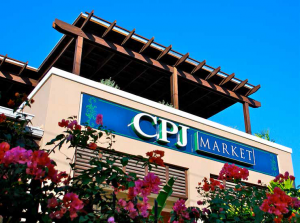
Caribbean Producers to be a big 2023 winner
The big surge coupled with the reopening of the Jamalco Alumina plant in Clarendon could result in the biggest growth in GDP for the first quarter in the country’s history since Statin has been reporting quarterly data on economic growth.
By extension the government will collect more revenues and the country will earn more foreign exchange. A number of listed companies will benefit in Major ways and others less significantly. The major beneficiaries are Caribbean Producers, Dolphin Cove, Everything Fresh and Express Catering. Lesser beneficiaries are Jamaica Producers, Wisynco, GraceKennedy, Cargo Handlers, Knutsford Express and Fontana with stores in Montego Bay and Ocho Rios.
Jamaica’s remittances exceed $3 billion
Remittance inflows into Jamaica in 2022 exceeded the $3 billion mark second year with US$3.1 billion inflows for the first eleven months of the year and ended just below the $3.18 billion collected in the similar period for 2021.
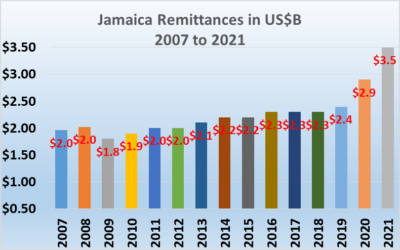 For the full 2022 year, remittances seem set to exceed $3.4 billion, close to the full year intake of US$3.497 billion in 2021. In November, remittance inflows rose 0.7 percent to US$276.5 million, from US$274.5 million in 2021 and are just one of the four months that inflows increased during 2022.
For the full 2022 year, remittances seem set to exceed $3.4 billion, close to the full year intake of US$3.497 billion in 2021. In November, remittance inflows rose 0.7 percent to US$276.5 million, from US$274.5 million in 2021 and are just one of the four months that inflows increased during 2022.
Five countries account for the bulk of the flows, with the United States of America accounting for 70.2 percent of total flows, up from 70.1 percent recorded for November 2021. The United Kingdom contributed 10.2 percent, followed by Canada and the Cayman Islands at 9.7 percent and 6.2 percent, respectively.
 The rate of inflation over the first two months of the year is 0.2 percent, in line with the average for the last four months and is now running at 45 percent below the average of 0.37 percent for the four months to February last year. Factors that could lower the pace, even more, are the recent revaluation of the Jamaica dollar and prices for some goods that are declining as new inventory items cost falls compared to the stock of goods in 2022 and most importantly the recent fall in the price of oil.
The rate of inflation over the first two months of the year is 0.2 percent, in line with the average for the last four months and is now running at 45 percent below the average of 0.37 percent for the four months to February last year. Factors that could lower the pace, even more, are the recent revaluation of the Jamaica dollar and prices for some goods that are declining as new inventory items cost falls compared to the stock of goods in 2022 and most importantly the recent fall in the price of oil.



